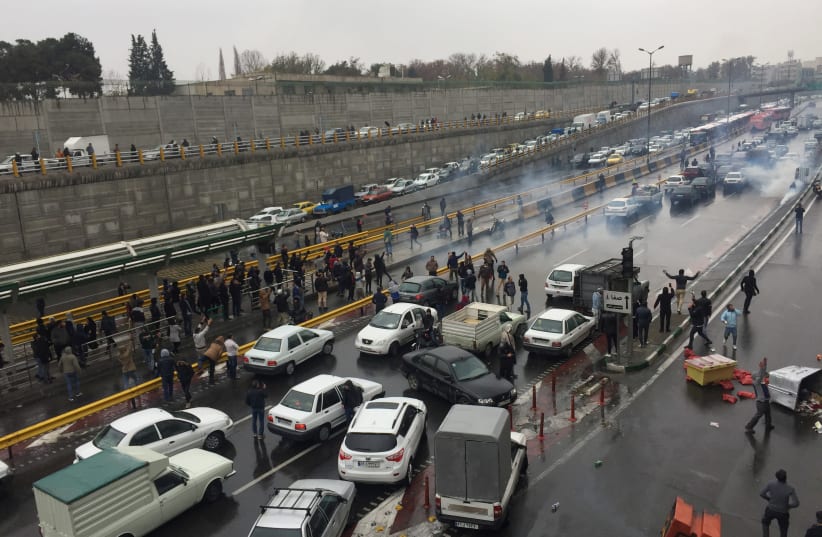کرمانشاه همین الانکرماشان به پا خواست✌️هر بژی ایرانهر بژی کرماشان#وعده_ما_پنجم_دی pic.twitter.com/IqAaBnvZ8x
— تیمسار سپهبد خلبان نادر جهانبانی (@jahanbaniiiiii) December 25, 2019
The semi-official news agency ILNA quoted an informed source at the Communications and Information Technology Ministry as saying the shutdown was ordered by "security authorities" and covered the Alborz, Kurdestan and Zanjan provinces in central and western Iran and Fars in the south.بهگفته #گزارشگرمنوتو تعداد زیادی نیروهای امنیتی در ملکشهر #اصفهان با شلیک تیر هوایی باعث ایجاد رعب و وحشت بین شهروندان شدند#پنجم_دی pic.twitter.com/jG6xcKCqzu
— اتاق خبر منوتو (@ManotoNews) December 25, 2019
"According to this source, it is possible that more provinces will be affected by the shutdown of mobile international connectivity," ILNA said. The Iranian news agency later removed the quote from their website, according to Radio Farda.Social media users also reported a heavy presence of armed forces in Tehran and other cities on Wednesday.سنندج امشب این شکلی بود به این میگن پیشواز pic.twitter.com/f24ZEPQaPP
— کَپیدِه قَشَنْگو (@kapideghashango) December 25, 2019
The internet watchdog NetBlocks confirmed that disruptions are affecting some mobile networks in Iran with reports of service failures in multiple cities. The data observed by NetBlocks are consistent with a targeted disruption and don't appear to be related to any international issue, unlike an internet outage last week when internet access was lost due to an issue in European services.Tabriz NW #Iran - a convoy of security forces parades on the streets while the #Iranian regime gets ready for #IranProtests and commemoration ceremonies for slain protesters called on by their families for Dec. 26. pic.twitter.com/ZpNPJz4r9K
— Iran News Wire (@IranNW) December 25, 2019
Social media posts and some relatives of people killed in unrest last month over hikes in gasoline prices have called for renewed protests and commemoration ceremonies for the dead on Thursday. Social media users are using the hashtags "see-you-Thursday" and "December 5th" in calls for protests and have begun using handwritten leaflets with hashtags in preparation for the internet outage, according to Radio Farda. A video on Twitter shows hundreds of leaflets that are being handed out by activists.Confirmed: Evidence of mobile internet disruption in parts of #Iran beginning ~6:30 a.m. (03:00 UTC); real-time network data show two distinct drops in connectivity this morning amid reports of regional outages; incident ongoing #Internet4Iranhttps://t.co/BNTPP9wEyt pic.twitter.com/1l1ZkLnQKJ
— NetBlocks.org (@netblocks) December 25, 2019
Video on social media claimed to show a motorcycle convoy on Wednesday in support of the protests planned for Thursday. Some reports indicated that protests were already starting up on Wednesday evening.پخش صدها بیانه دست نویسی توسط مبارزان ازادی خواه میهن برای دعوت از مردم برای حضور در خیابانها#وعده_ما_پنجم_دی pic.twitter.com/yBcd5JeUrk
— Ali (@Ali43694277) December 25, 2019
The parents of slain protester Pouya Bakhtiari were arrested on Monday night "to protect order and the security of the people who have incurred damage and loss" after they planned to hold a public memorial service for Pouya, according to Radio Farda. Some of his other relatives were also arrested, according to a relative. The Bakhtiari family is one of the few families that has risked discussing the death of their son who was peacefully protesting with international media.On Tuesday, US Secretary of State Mike Pompeo called for the release of Pouya's parents. "It’s time for the international community to stand together with the Iranian people and hold the regime accountable," tweeted Pompeo.During widespread anti-government protests in November, Iran shut down Internet access throughout the country.Iran is currently in the process of developing a national intranet system, known as the National Information Network (NIN), in order to cut the country’s dependency on international cyberspace, according to Radio Farda. The network will also prevent Virtual Private Networks (VPNs) from helping Iranians bypass the Islamic Republic’s censorship of the Internet, as data requests won’t be routed outside the country.The plan was first announced in 2010 with an expected completion date in 2015. In May, the Supreme Council of the Cultural Revolution announced that the NIN is 80% complete.“All domestic activities, services, applications [and] various types of contents... are included in the national Internet,” said Communications and Information Technology Minister Mahmoud Vaezi at the inauguration event in 2016, according to the BBC.Iran has already blocked access to tens of thousands of sites and services including Twitter and Facebook, although many users use VPNs and proxy sites to bypass the filter.Earlier in December, Iranian President Hassan Rouhani promised that the NIN would be strengthened so that “people will not need foreign [networks] to meet their needs.” The announcement came soon after the government temporarily shut down Internet access throughout the country during anti-government protests, sparking fears among Iranians that they could soon be cut off from accessing the outside world through the Internet.The intranet would allow the government to decide what content can be accessed by users, removing the need for absolute shutdowns like the one imposed during the protests.Some Iranian newspapers warned the government against imposing such a decision on citizens, as things could easily spark out of control as they did after gasoline prices were raised in a sudden decision by the nation’s leadership, according to the People’s Mojahedin Organization of Iran, an Iranian militant opposition group. A state-run daily called the announcement a “threatening message to the people,” while another daily asked, “will the people and the private sector tolerate the Internet shutdown?”Reuters contributed to this report.#IranAnother uprising in Iran is nearing its birthWith an initiative in Najaf Abad streets, demonstrators riding a motorcycle took photos of the martyrs of the November uprising#IranProtests. #اعتراضات_سراسری pic.twitter.com/fLrOB0mnFJ
— mostafa.m (@MostafaMe4) December 25, 2019
